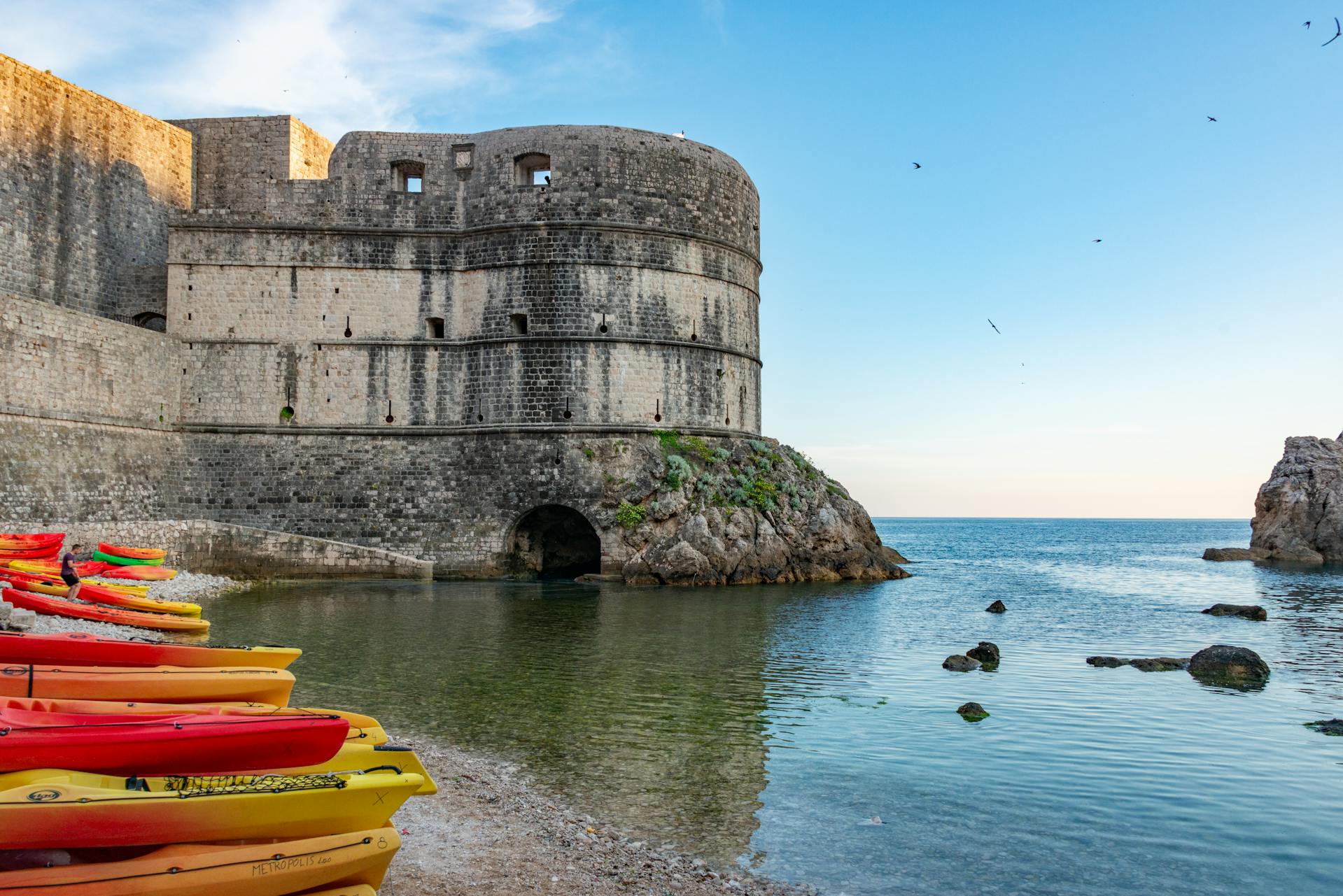Best months to visit Dubrovnik
Dubrovnik is one of those places that feels completely different depending on when you visit. The same stone streets, sea views and terraces can look and feel new each season. Some travelers come for the sun and sea, others for the quiet streets and mild weather. The truth is; there’s no bad time to come, but the experience will change depending on what you’re looking for.
The city’s rhythm follows the Mediterranean pattern: warm, dry summers and mild winters, with spring and autumn offering that perfect middle ground. From April to October, Dubrovnik feels alive. Boats pass through the harbor, terraces stay full until late and the air smells like salt and sunscreen. In winter, it slows down, showing a side that locals know best: calm, friendly and more personal.
We’ll help you choose the best months to visit Dubrovnik based on what you enjoy most, from swimming in turquoise waters and walking the city walls to exploring local festivals and off-season charm.
Best months to visit Dubrovnik – quick overview
| Preference | Best months | What to expect |
|---|---|---|
| Warm weather & swimming | June – September | Hot, lively, ideal for beaches |
| Fewer crowds & sightseeing | May, September, October | Comfortable, great balance |
| Budget-friendly travel | November – March | Quiet, cheaper stays, mild weather |
| Local events & culture | February (St. Blaise), July-August (Summer Festival), October (Good Food Festival) | Festivals, traditions, local life |
Visiting Dubrovnik in Spring (April to May)
After the quiet winter months, Dubrovnik wakes up in spring. Cafés start reopening, the first cruise ships return and locals prepare for the upcoming season. It’s the time when the city is not too hot, not too crowded and perfect for walking.
April is the start of the season. Days are mild, averaging around 15°C (59°F), with more sun than rain. You’ll see flowers blooming along the city walls and the sea starts turning its deep summer blue. While some hotels and restaurants still operate on shorter hours, most are open by Easter. This is also the month when the city begins to host cultural events and flights from across Europe increase.
The average temperature in May reaches 21°C (70°F) and daylight stretches well into the evening. The sea warms up enough for swimming (around 19°C), though locals will still call it “fresh”. Crowds remain manageable, prices are lower than in summer and it’s one of the best times to enjoy Dubrovnik’s Old Town without rushing. In May, Dubrovnik hosts several small outdoor events, from local music evenings in Lapad Bay to open-air food markets. It’s also the start of vineyard tours on the Pelješac peninsula, a short drive away, which is a great option if you want a mix of history and countryside.
Spring is perfect for walking tours, island hopping, or taking the cable car to Mount Srđ for views of the Adriatic. You can still find available tables in popular restaurants without reservations, while day trips to nearby places like Cavtat or Konavle are easy to organize.
What to pack: Layers, a light jacket for evenings, sunglasses, comfortable shoes for the City Walls.
Visiting Dubrovnik in summer (June to August)
Summer is the most popular time to visit Dubrovnik, especially for travelers who want to combine sightseeing with beach days.
June is ideal for those who want a summer atmosphere without extreme heat. The average temperature is around 26°C (79°F) and the sea is already warm (about 23°C). All restaurants, bars, and tours operate at full capacity. It’s a great month for evening walks along Stradun or swimming at Banje Beach just outside the Old Town walls.
July and August bring high heat, often above 30°C (86°F), and large crowds. These are the months when Dubrovnik hosts major cultural events. The Dubrovnik Summer Festival, from mid-July to late August, fills the city with open-air theatre, concerts and dance performances. Smaller seaside towns like Mlini and Cavtat also come alive with music and local celebrations.
Because of the heat, sightseeing is best done early in the morning or later in the afternoon. During the day, you can take a ferry to Lokrum Island for shade, swimming or a picnic. The sea temperature peaks around 25°C (77°F), which is excellent for diving or kayaking tours along the coast.
If you plan to visit in July or August, book accommodation and tours well in advance. Prices are at their highest, but this is also when Dubrovnik feels most energetic and alive.
What to pack: Light clothes, a hat, sunscreen, refillable water bottle, sandals for rocky beaches.
Visiting Dubrovnik in autumn (September to October)
If you ask locals for their favorite time of year, most will say autumn. The weather stays pleasant, the sea is still warm and the crowds thin out. It’s the perfect mix for those who want to see and do everything without the summer rush.
September feels like an extension of summer. Temperatures are around 25°C (77°F) and the sea remains warm for swimming. It’s easier to find tables in popular restaurants and tickets for day trips to islands like Šipan or Lopud. You can still enjoy outdoor concerts and lively evenings, but at a calmer pace.
October brings a softer side of Dubrovnik. The heat fades, evenings become cooler and the city takes a breath after the busy season. The weather can be unpredictable. A sunny morning might turn into a short shower in the afternoon, but that’s just part of its charm. It’s still comfortable for walking and you’ll see more locals returning to their favorite spots in the Old Town.
October also hosts the Good Food Festival, a week dedicated to local cuisine. You can join workshops, tastings and food tours that highlight the region’s wines, olive oil and seafood.
Autumn offers the best value for travelers. Lower hotel prices, pleasant weather and an atmosphere that’s both lively and relaxed. For many, this is the best time to visit Dubrovnik and Croatia in general.
What to pack: Comfortable walking shoes, a mix of short and long sleeves, a light raincoat.
Visiting Dubrovnik in winter (November to March)
Winter in Dubrovnik can be surprisingly atmospheric. Locals gather for coffee at Gundulić Square even on chilly mornings and weekend markets sell fresh citrus and homemade liqueurs. Some museums, like the Rector’s Palace, remain open year-round, while accommodation prices drop dramatically.
From November, temperatures drop to around 15°C (59°F) and rainfall becomes more common. Many tourist-oriented businesses close, but local cafés and restaurants stay open. For those traveling on a budget, this is the most affordable time of year. In this period accommodation prices can drop by half compared to summer.
December is a wonderful surprise. The Dubrovnik Winter Festival fills the Old Town with Christmas lights, music and local treats. You’ll find markets selling traditional sweets, handmade gifts and mulled wine stands on every corner.
We’ve prepared a complete list of things to do in Dubrovnik during winter, check it out.
In February, Dubrovnik celebrates its patron saint, St. Blaise, with processions, costumes and concerts. This festival has been held for more than a thousand years and gives visitors a glimpse into the city’s deep traditions.
By March, the first signs of spring return. There are almond trees blooming, outdoor cafés reopen and temperatures slowly rise. It’s a peaceful time to explore, which is ideal for those who like quiet streets and local encounters.
What to pack: A warm jacket, umbrella, waterproof shoes. Days are short, so plan sightseeing early.
Best time to visit Dubrovnik for different travelers
- For families: June or early September; warm weather, calm sea, fewer crowds
- For couples: May or October; romantic light, pleasant temperatures, relaxed pace
- For photographers: April and October; softer sunlight and fewer people in shots
- For cruisers: July and August; peak sailing season, but plan shore time early morning
- For hikers and adventurers: April-June or September; perfect for Mount Srđ trails and kayaking
Dubrovnik climate by month
| Month | Average High | Sea Temp | Rain (Days) | Atmosphere |
|---|---|---|---|---|
| April | 15°C | 17°C | 7 | Fresh, calm start to the season |
| May | 21°C | 19°C | 6 | Warm, balanced, great for walking |
| June | 26°C | 23°C | 4 | Start of summer, lively evenings |
| July | 30°C | 25°C | 3 | Hot, vibrant, crowded |
| August | 31°C | 26°C | 3 | Peak summer fun |
| September | 25°C | 25°C | 5 | Warm, easygoing, fewer crowds |
| October | 20°C | 22°C | 8 | Pleasant, relaxed, cultural |
| November | 15°C | 19°C | 9 | Mild, rainy, quiet |
| December–February | 12–14°C | 17°C | 9–10 | Peaceful winter months |
| March | 14°C | 17°C | 8 | Reawakening of the city |
Best time to visit Dubrovnik’s City Walls and Old Town
The best time of day to visit Dubrovnik’s City Walls is early in the morning, around 8 AM, when they first open. The light is soft, temperatures are mild and you’ll avoid most of the day-trippers. Late afternoon is another good option (around 5 PM in summer) for golden-hour photos and fewer crowds.
As for the best day of the week to visit Dubrovnik, midweek days like Tuesday and Wednesday are the calmest. Saturdays and Sundays tend to attract more visitors, especially locals on short trips.
If you want to explore without the heat or crowds, plan your visit for spring or early autumn. You’ll have clear skies, moderate temperatures and space to move freely along the walls.
Practical travel tips
- Book in advance in summer. Hotels, city tours, and restaurant tables fill quickly in July and August.
- Avoid cruise ship crowds. Check the port schedule; fewer ships mean a quieter Old Town.
- Stay hydrated. Tap water is safe to drink in Dubrovnik, and refillable bottles save money and plastic.
- Dress for the terrain. The streets are polished stone and can be slippery; flat, comfortable shoes are best.
- Bring cash. Cards are widely accepted, but smaller cafés, taxis, and bus tickets often require cash.
- Explore nearby. Short trips to Lokrum, Cavtat, or the Elafiti Islands are easy to organize in any season.
So, what is the best month to visit Dubrovnik?
If you’re looking for the best balance of pleasant weather, open attractions and manageable crowds, choose May, September or early October. The sea is warm enough for swimming, the days are long and the atmosphere is relaxed. A perfect mix of energy and calm.
Each season brings out a different character of the city. Summer is bright, lively, perfect for those who want full beach days and festivals under the stars. Autumn offers warm temperatures of the sea, local food events and easier travel. Winter slows things down, shows a more authentic, local rhythm, while spring welcomes back the sun and opens the season with fresh colors and comfortable temperatures.
If you love the buzz of long evenings and swimming in clear water, come between June and August. For peaceful exploration, milder weather and great value, plan for May, September or early October. And if you’re drawn to quiet streets, local cafés and winter festivals, you’ll find a surprisingly warm atmosphere even in January.
Whatever time of year you visit, make sure to walk the city walls in the morning light and watch at least one sunset over the Adriatic. Dubrovnik looks different every hour. And that’s exactly why travelers keep coming back.
Photo: Pexels







